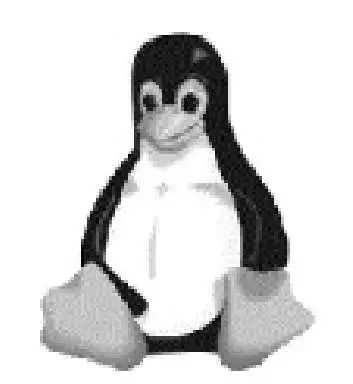
Linux is an operating system kernel released under the General Public License (GPL) and complies with the POSIX standard. However, when people refer to Linux, they usually mean GNU/Linux (GNU is a complete free software system compatible with UNIX), which includes the kernel, system utilities, and application software, rather than just the Linux kernel itself.
There are many distributions of Linux. A distribution refers to a collection of the Linux kernel, source code, and related applications organized and released by companies, organizations, or individuals. Classic Linux distributions include Red Hat, SlackWare, and Debian. Currently popular Linux distributions are mostly based on these, such as the community version of Red Hat, Fedora Core; SuSE Linux released by Novell; Mandriva Linux released by Mandriva; and Knoppix, Slax, and Ubuntu Linux based on Debian, which use LiveCD technology.
The Linux mascot is a penguin named Tux:
 Tux
Tux
In the 1980s, IBM launched the globally renowned microcomputer IBM PC (Personal Computer). With the emergence of PCs, it gradually became possible to implement a real UNIX system on PCs, but at that time, there were very few UNIX systems that could run on the PC’s X86 platform.
In 1987, Professor Andrew Tanenbaum designed a simplified UNIX system called Minix for teaching purposes.
In 1991, Linus Torvalds, a graduate student at the University of Helsinki, developed the Linux kernel based on Minix. On October 5 of the same year, Linus Torvalds announced the birth of the Linux kernel system on the comp.os.minix news group.
In 1994, a small group of programmers in North Carolina began releasing Red Hat.
In 1998, the Red Hat Advanced Research Laboratory was established, and that year, Red Hat 5.0 won the InfoWorld Operating System Award.
Due to Linux’s advocacy for openness and freedom, there are many distributions available. Linux software is spread all over the internet, often requiring users to search, collect, and download themselves.
To facilitate installation, some people bundle various software together with the operating system’s core to create a Linux distribution. Among them are currently famous distributions such as Ubuntu Linux, Fedora Core, Mandriva Linux, SuSE Linux, Debian, Slackware Linux, and domestic Red Flag Linux. Below are brief introductions to five commonly used Linux distributions.
CentOS (Community Enterprise Operating System) is one of the Linux distributions, compiled from the source code released by Red Hat Enterprise Linux according to open-source regulations. Because it comes from the same source code, some servers that require high stability use CentOS as a substitute for the commercial version of Red Hat Enterprise Linux. The difference between the two is that CentOS does not contain closed-source software.
Red Hat Linux is released by Red Hat and is currently a popular commercial distribution. As the most influential version in the Linux world, Red Hat Linux was born on November 3, 1994, and its created RPM package management system has long been the de facto standard in the industry. Currently popular distributions such as SuSE Linux, Mandriva Linux, and domestic Red Flag Linux are all developed based on Red Hat Linux. Since September 22, 2003, the previously merged Fedora and Red Hat have been released separately, forming two branches: the open-source free Fedora Core and the commercial version Red Hat Enterprise Edition.
SuSE Linux was originally based on Slackware Linux and provided a complete German user interface. In 1992, Peter McDonald established the Softlanding Linux System (SLS) distribution, and thereafter, SuSE Linux adopted many features of Red Hat Linux, such as using RPM, etc., sysconfig, and more.
Ubuntu Linux is currently a popular Linux distribution and has almost replaced Red Hat as the synonym for Linux. It was founded by Mark Shuttleworth, with the first version released on October 20, 2004, based on Debian. Ubuntu primarily relies on support from Canonical Ltd. The name Ubuntu comes from the Zulu or Hausa word meaning “humanity to others.” Related distributions include Kubuntu Linux and Edubuntu Linux.
Debian was first released on August 16, 1993, by Ian Murdock, a student at Purdue University in the United States. Ian Murdock initially named his system “Debian Linux Release.” Debian is not commercially oriented and has no commercial group support, allowing it to maintain its free style. Debian’s adherence to the GNU and UNIX spirit has garnered widespread support from the open-source community. Currently, its deb package and Red Hat Linux’s RPM package are the two most important package management systems in Linux.
It is well known that both Microsoft’s Windows and Apple’s Mac OS require payment, and are quite expensive. In contrast, Linux is free and open-source, allowing users to access its source code at any time and customize it according to their needs, which is especially important for users, particularly program developers.
Since most of the Linux kernel is written in C and adopts a portable UNIX standard application interface, it supports various system platforms such as i386, Alpha, AMD, and Sparc, as well as a range of hardware devices from personal computers to mainframes, including embedded systems.
Unlike other operating systems, after installing Linux, commonly used office software, graphics processing tools, multimedia playback software, and network tools are often pre-installed. For program developers, Linux is an excellent development platform, as its package includes multiple programming languages and development tools, such as gcc, cc, C++, Tcl/Tk, Perl, Fortran77, etc.
As a UNIX-like system, Linux, like UNIX, is a true multi-user and multi-tasking operating system. Multiple users can each own and use system resources, meaning each user has specific permissions for their resources (such as files and devices), without affecting each other. At the same time, multiple users can use the computer system online at the same time. Multi-tasking is one of the main features of modern computers, and because Linux’s scheduling allows each process to access the processor equally, it can execute multiple programs simultaneously, with each program running independently.
Linux is an operating system with inherent immunity to viruses, and is rarely attacked by them.
For an open system, while it is convenient for users, it may also present security risks. However, by utilizing tools such as built-in firewalls, intrusion detection, and security authentication, timely patching of system vulnerabilities can greatly enhance Linux’s security, making it difficult for hackers to exploit. Additionally, since Linux is open-source, it has generated a variety of different versions, which also increases the difficulty of being attacked.
The source code of the Linux kernel is optimized for standard 32-bit (64-bit on 64-bit CPUs) computers, ensuring system stability. It is precisely because of Linux’s stability that some machines running Linux can remain operational for years without shutting down, just like UNIX machines.
Linux comes with a wealth of free network server software, databases, and web development tools, such as Apache, Sendmail, VSFTP, SSH, MySQL, PHP, and JSP. In recent years, more and more companies have recognized these powerful capabilities of Linux and have utilized it as a comprehensive network server.

Author’s Note: In today’s internet era, regardless of the profession, having a certain understanding of IT is beneficial for personal development. I will continue to update my IT learning skills in the future, hoping to benefit you while continuously pushing myself forward.
Everyone is welcome to follow, comment, and discuss skills and techniques, learning and growing together.
Author’s Declaration: Since the establishment of this account, I have been sharing knowledge for public benefit, not for advertising, but for sharing interests.
Scan the QR code
to get more exciting content
IT Technology Hub

